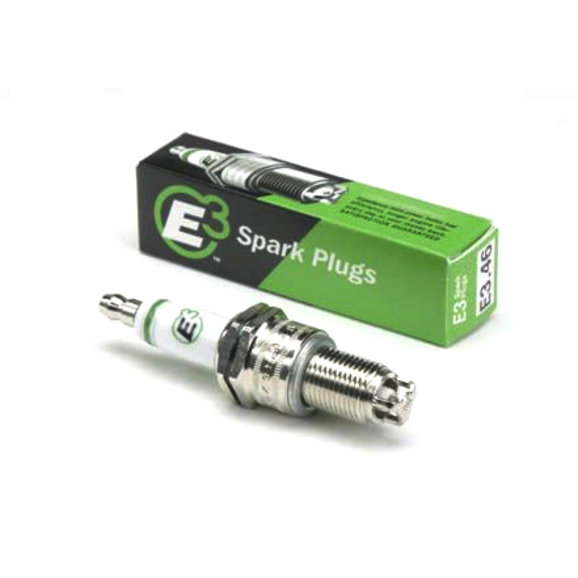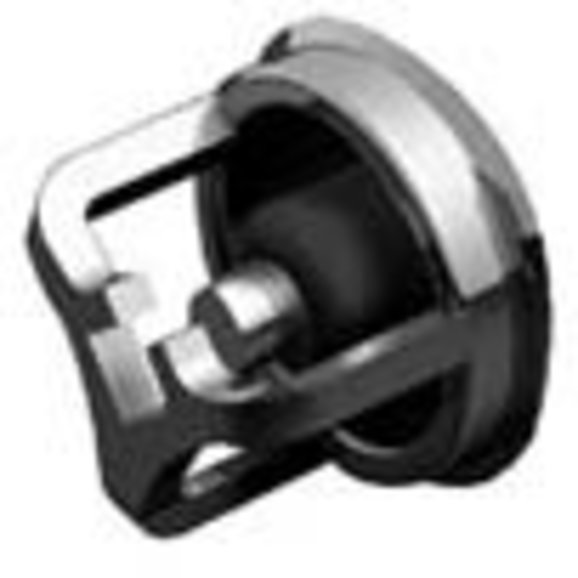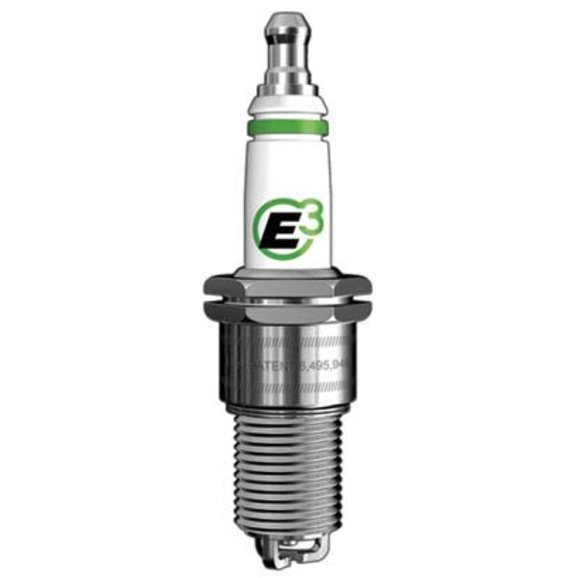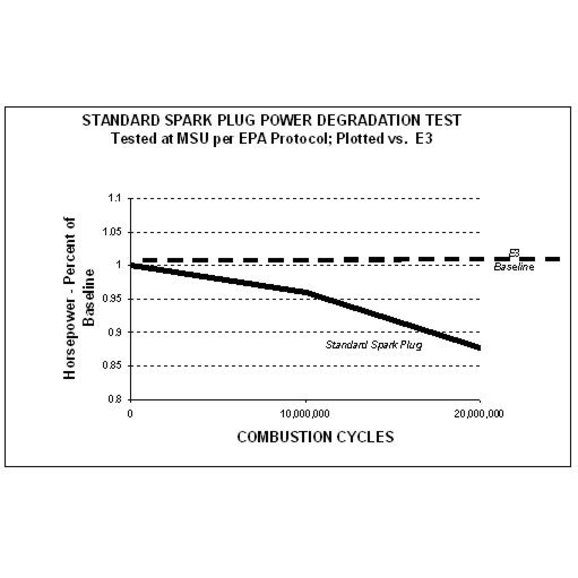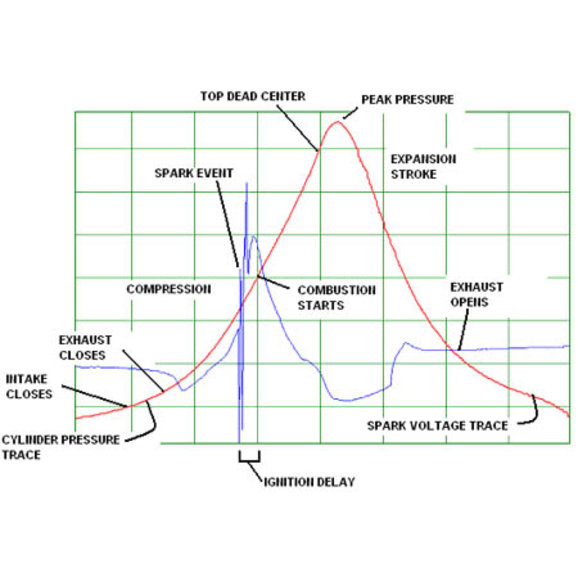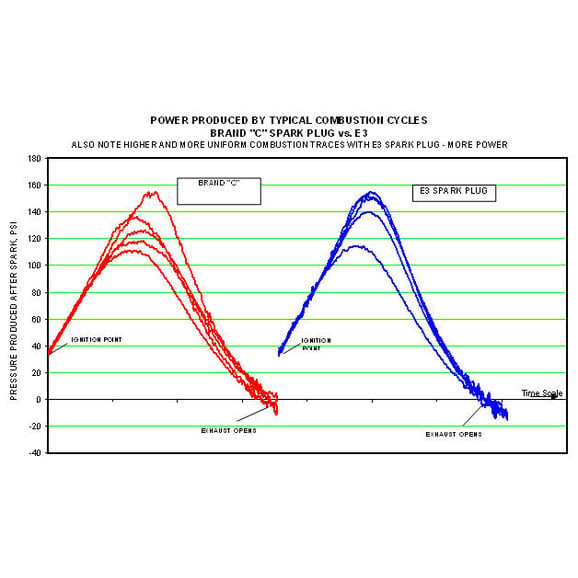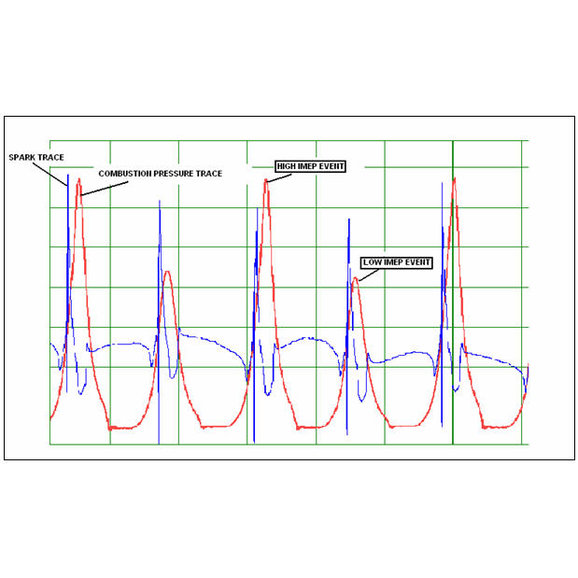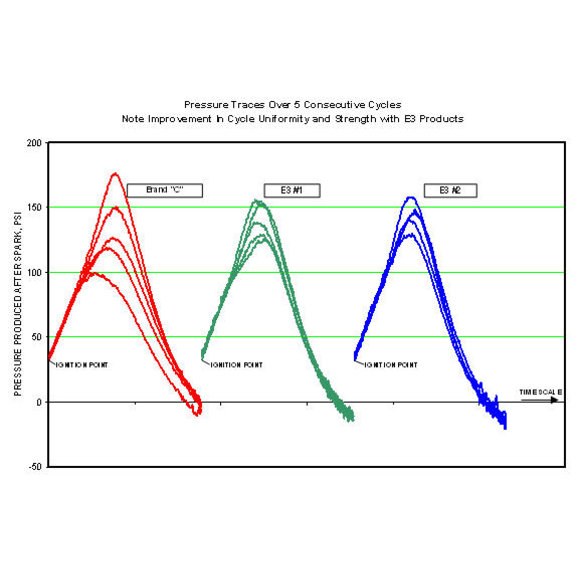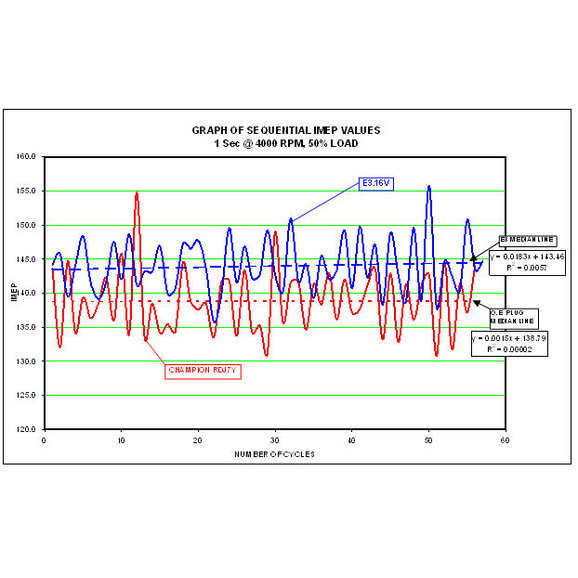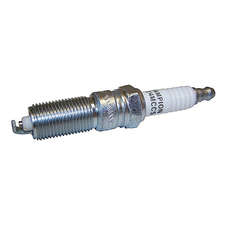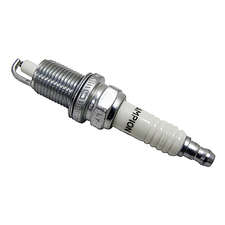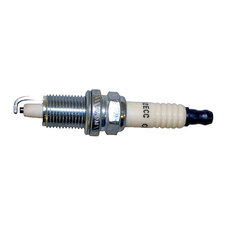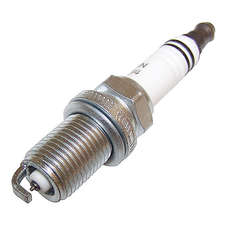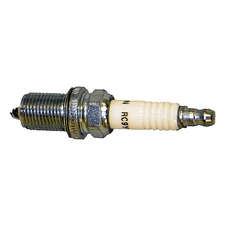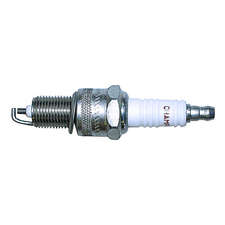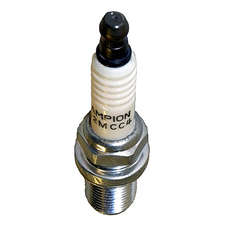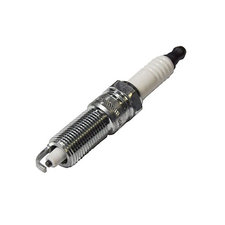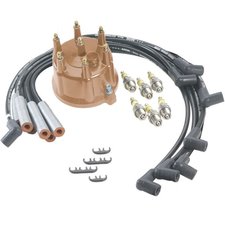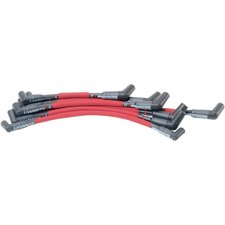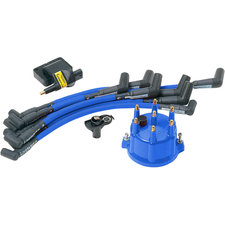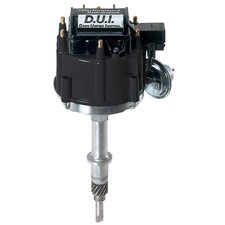The E3 spark plug design came out of a dedicated series of laboratory experiments working to maximize the power created by a spark plug. For the most accurate measurement of power, we studied the actual pressure rise from a single combustion event with different style spark plugs. In technical terms, this is done by measuring the Indicated Mean Effective Pressure (IMEP) created by a running series of combustion cycles and comparing the values from one spark plug to another, all other parameters being kept equal (load, rpm, temperature, humidity, etc.). We focused on maximizing the peak pressure created by our proposed electrode designs. Double blind tests were run comparing the area under the pressure curve itself (the "work" created) for 500 combustion cycles per spark plug design. We also evolved our electrode designs with the goal of reducing the Coefficient of Variance (COV) of a series of combustion cycles. We performed this work at our test labs in Atlanta, and then continued the development at Georgia Tech and Michigan State University's Engine Research Laboratory.
The spark plug electrode design we ended up with is a combination of the benefits of three types of known performance plugs, plus some new science thrown in. This design outperformed all other spark plug designs available, including premium offerings from the major manufacturers. There are three main components to how the new electrode configuration works, as discussed in the following text:
One component mimics surface gap spark plugs (such as are used in rotary engines and others) which present the flame kernel to the piston (or rotor) more directly, reducing the travel time from the spark zone to the end gases by avoiding the "doughnut" shaped flame kernel produced by standard plugs. This is achieved in the E3 design through the open section at the top of the electrode. Given the short time available to get combustion started, the faster you can get the flame to the piston, the better.
Another part of the E3 benefit comes from the forward projection of the electrode into the combustion chamber which gets the spark zone closer to areas of probable "good" air/fuel mixture, rather than having the spark lying against the combustion chamber wall as with retracted or standard plug designs. The outward projection mentioned above also serves to create beneficial "micro-aerodynamics within the spark zone. The initial combustion wave leaves the spark area at supersonic speeds above Mach 1, and the elevated edge provides somewhat of a chimney effect for the next round of air/fuel mixture to get into the spark zone. Filling this spark zone physically has to happen up to 150 times per second on racing motorcycle engines - part of the whole problem of ignition in engines.
The strongest part of the E3 electrode design is the forced edge-to-edge spark discharge, which is the best way to get a spark to leave a surface. Our design improves upon the phenomena that drove racers to use and/or make themselves what are known as "cut-back" electrode spark plugs all these years. The spark itself does not occur until there is an avalanche of electrons migrating from the two electrodes (anode to the cathode). Sharp edges are better at initiating electron migrations, and these accelerated electrons collide with matter within the spark zone to release additional electrons, the whole population of electrons working to create a plasma channel through which the spark current flows.
The following computer models graphically show the difference between a traditional spark plug's flame kernel and the improved flame front produced by the E3 spark plug.
STANDARD SPARK PLUG FLAME KERNEL SHAPE
- Horizontal projection Flame quenches on cylinder walls
- Time delay in flame growth longer path to piston head
E3 SPARK PLUG FLAME KERNEL SHAPE
- Note the flame kernel's projection toward piston head
- Flame moves toward piston and bulk air/fuel mixture less quenching on cylinder walls
- Reduced time delay in flame growth shorter path to piston head
- Faster flame growth compared to standard plugs
- Larger flame kernel moves heat faster into combustion chamber
- Larger flame front creates more localized pressure, making a faster pressure rise in cylinder during the power stroke
The problem with sharp edges, as the racers will tell you, is that they wear too fast for long term use (i.e. they wear out after about one hour of hard use). With our design, we present four sharp edges to the circular sharp edge of the center electrode, which allows the spark to seek the path of least resistance, which it will naturally do. As a spark channel forms between two opposing spots of the electrode pair, the local resistance will increase as the localized temperature grows due to the energy flow during the spark event. After a few sparks, the local resistance becomes high enough to cause the spark to seek alternate sites to initiate from and to land on, and this moves the spark channel around enough over a series of sparks to prevent the arc welding type of material depletion of either electrode. Our prototypes outlasted all non-platinum spark plug in longevity even though they were made from mild steel. For production plugs, we use a special high-temperature alloy with a high nickel content plus additional elements to make an extremely long-lived electrode pair.
One other benefit of how we present two opposing sharp edges to each other is that our design is able to keep its freshness much longer than standard plugs. Comparing new plugs to new plugs, our design creates more power while using less fuel (brake specific fuel consumption) than any other design. What was a new revelation for us during testing was that standard plugs degrade pretty quickly, loosing up to 10% of their power after just 50 hours of use (about 1,200 miles in a typical car). This is why we racers have been changing spark plugs between heats all these years: Fresh spark plugs make more power. Now, with the new E3 design, the sharp edges make better combustion when new and keep sufficient sharpness to the opposing electrode edges to promote the effect deep into the spark plug's life cycle. You can see this in the graph above:
Additionally, the three legs that support the special geometry of our design serve to move a lot of thermal loading (heat) out of the ground electrode, which is good for electrode longevity. Our center electrodes are forged with a copper center core surrounded by a nickel alloy sheath and tip. The copper is not there for electrical conductivity, it performs the function of pulling the heat out of the center electrode's tip to help longevity. Copper-cored center electrodes come pretty close to doing what platinum can do for electrode life.
COMPETITIVE SPARK PLUGS
Some competitive spark plugs are constructed in such a way that the spark starts from the flat portion of the center electrode, at best you can get an flat-to-edge spark. However, that spark is shielded (as you view it from the working end, just how the piston would see the plug) by the ground electrode itself. This shielding is what standard J wire spark plugs do as well, and is the antithesis of what you want to do with a flame kernel. The goal is to get the total population of air and fuel to combust, and to do that you need to get the maximum amount of surface area to your flame kernel and get it aimed toward the piston as soon as possible. Making the flame front travel sideways or even at an angle uses up precious milliseconds during the combustion process. This type of spark plugs do little more than standard plugs due to the same sort of shielding created by the ground electrode, and by the lack of a true edge-to-edge firing configuration. It may seem subtle, but seven years of testing has shown that unless you establish an edge-to-edge spark, the ignition process is not significantly improved upon over standard spark plug flat-to-flat designs that have been around for 100 years.
Fine wire spark plugs move a bit towards at least one edge discharge for the spark, but generally fire the spark to the flat underside of a J wire electrode. Fine wire plugs were designed to create a way to reduce the cost of a platinum or iridium electrode- the less material the lower the cost. That a fine wire spark plug fires a bit better is an unintended benefit, giving some idle stability and fouling resistance. A fine wire center electrode firing to a U-Groove ground electrode is about as good as you can get from the major manufacturers. The E3 Spark Plug design takes things to a higher level, and outperforms the U-Groove plugs by really maximizing the exposed edges and spark presentation to the combustion chamber.
The well respected V-Groove spark plug is a good example of making a better spark by offering at least one edge to fire from. The engineers of the V-Groove found a hint at the improvements we were able to achieve, but the V-Groove design results in only an edge-to-flat spark discharge, and the performance improvement is on par with fine wire spark plug designs.
The U-Groove design does the same sort of thing the V-Groove does it presents some edges to the center electrode. The net result is a flat-to-edge spark discharge that performs similarly to the V-Groove design.
As good as these designs are the significant discovery that our company's researchers made was that having two edges firing to each other is more than twice as good as an edge-to-flat electrode design. With an edge-to-edge design the electrons form the plasma channel faster and stronger when both the anode and the cathode are sharp. The effect is based on the phenomena of how electrons in conductive materials behave near to sharp edges or protrusions. Not only is the ignition delay reduced by the E3 Spark Plug design, but the electrical-to-chemical energy transfer is measurably improved, resulting in a faster and larger flame kernel.
GOING DEEPER: IGNITION THEORY
The spark itself ignites whatever air and fuel is in the spark zone, and this creates the flame kernel. The remainder of the ignitable mixture will be ignited by one of the following conditions: contact with the flame front; if the pressure gets high enough (as how a Diesel engine ignites its mixture); and if the temperature rises high enough (which, if it happens too early, is pre-ignition). If the flame kernel is small, the remaining mixture can ignite all by itself as the pressure and temperatures rise as a natural response to the flame kernel coming into existing within the combustion chamber: This is what detonation comes from.
In theory, perfect combustion would be detonation, an instantaneous deflagration of all the combustible mixture while the piston was holding the combustion chamber at a constant volume. This is the whole theory behind the Otto-cycle engine. In practice, there is an ignition delay between the time that the spark breakdown occurs, when the flame kernel grows, and as the flame front moves across the combustion chamber. Engine designers time all of the events such that peak pressure within the combustion chamber occurs when the piston is around 20° after top dead center (ATDC). This puts the crankshaft in a pretty good position to offer a good lever to the piston and connection rod.
Just after the instant of spark breakdown, you have coexisting in the combustion chamber a developed flame kernel and the remainder of the unburnt air/fuel mixture filling the space outside of the flame kernel. To get the residual air/fuel mixture to ignite, the engine system is designed to increase the temperature of the remaining gases, to raise their pressure, and to expose them to a flame. A larger flame kernel is very effective (exponentially so) by offering more mechanisms for heat transfer: The larger ball of the flame kernel has more surface area, so conductive heat transfer is greater. The larger surface area also creates more radiative surface, giving a greater radiation heat transfer to the unburnt gases. Finally, a larger flame kernel that is expanding at a rapid rate creates much more turbulence, which strongly affects convective heat transfer by tumbling and mixing the remaining air/fuel mixture into the combustion process (exposing more air/fuel population sites to conductive and radiative heat transfer, and so on). So, even just a slight improvement in flame kernel strength can have a cascading improvement in the combustion process. By getting the flame process started earlier, the mass fraction burned at any given crank angle position away from TDC is improved.
The net result from all of this is that the air and fuel mixture that is already ingested into the combustion chamber is more completely burned. Since the exhaust valve opening is going to occur at a fixed point in the crank's position, it is very important to get as much of the fuel burned before it is vented off by the exhaust valve.
COMBUSTION CYCLE ANALYSIS
By measuring the pressure inside the cylinder while the engine is running, very accurate details of the combustion process can be analyzed.
Looking at the graph below, you can see the plots of ignition voltage (blue line) and cylinder pressure (red line). The red line starts to rise as the piston moves upward (all valves closed) starting compression. At the right moment, usually around 28° before Top Dead Center (TDC), the ignition system will send voltage to the spark plug. There is an time lag of a few milliseconds from the time that the current is sent to the spark plug and when the spark actually starts combustion this is called the ignition delay. Once combustion starts, the pressure rises rapidly and peaks after TDC. This is done so that the maximum pressure is on the piston when the connecting rod is at a better angle with respect to the crankshaft so it can push hard with good leverage. During the expansion stroke (power stroke) the combusted gases are expanding rapidly and pushing hard on the piston. At a fixed moment in time (unless the engine has variable valve timing) the exhaust valve opens an starts to vent off the pressure in the cylinder, meaning that no more work is done on pushing the piston.
Two things are of interest in looking at cylinder pressure graphs. One is the peak pressure and area under the pressure curve as created by one spark plug or another. All of the power that an engine makes comes from the area under this pressure curve. If a spark plug can make a higher average pressure for every combustion cycle, it makes more power.
You can measure power improvements on an engine dyno, but you are seeing the combustion process pretty far downstream. The most accurate and sophisticated way to measure power is to look at the cylinder pressure over a number of cycles (such as 500 cycles) and statistically compare one modification to another. The flywheel serves to integrate the cycles over time, and the individual pulses of each combustion event are lumped together, making nuances of improvements hard to determine. Major race teams from NASCAR to Formula 1 are now instrumenting their cars for in-cylinder pressure measurements for optimal tuning. E3 engineers pioneered this practice seven years ago.
The following graph shows how the E3 spark plug compares to a standard spark plug in making higher pressures in a test engine. The higher and more consistent pressure levels directly result in more power and less emissions, while burning less fuel. You can see how the fuel is being put to use in driving the piston downward, and less fuel is getting blown out the exhaust because it did not get converted to power. This is the core of the substantial performance improvement made by the E3 spark plug electrode design, and is why the technology is so significant.
The second thing to observe in pressure traces is the variation of peak pressure values from one combustion cycle to the next. As much as you might expect it, not all combustion cycles make the same power. A great running engine will still have a 5% drift in pressure values from one power stroke to another. A poor running engine will have 10% or more. This is called coefficient of variability and can be seen in the next graph. Some combustion events result in high pressure production, others result in low pressure. The graph shows successive combustion events taken in real time, showing how one cycle regularly varies from another, even while the spark plug is firing very well.
For the E3 spark plug, you can see from the recorded graphs that the combustion pressures are higher and more regular over successive combustion events. This leads to more power, and helps reduce emissions and improve fuel economy. Pressure traces of this sort show up in every engine the E3 spark plug is installed in we've been testing all sorts of engines since 1997 and always see a good response.
The next graph shows how the E3 spark plug improves pressures over a series of combustion cycles and how this adds up to better power. The blue line was measured over a successive number of power cycles using E3 spark plugs. The pressure peaks are higher and more uniform than the standard spark plug (shown in the red line). If you take an average of the pressure curves, you get the dotted lines. The blue dotted line shows the running average of the E3 spark plug pressure/power production. The dotted red line shows a lower average for the standard spark plug.
This type of analysis has been done for all kinds of engines by the E3 Spark Plug researchers, and we always see this type of improvement in automotive engines, small two strokes, high revving racing four strokes, etc. Making the flame front faster and the combustion pressure rise faster always results in more complete combustion and this directly improves engine performance.
THE NET RESULT:
To Summarize all of this: The faster flame front and pressure rise created by the E3 spark plug gets more of the fuel converted to work and gets it to the piston head before it is vented off by the exhaust valve. Studies have shown that for optimum tuning, an E3 spark plug allows an engine designer to use a slightly earlier exhaust valve closing than a standard plug, if they chose to do so. For some engines, this allows a further improvement in power by reducing the valve overlap and intake charge losses through blow-through from the intake to exhaust valve.
- Shipping Weight: 0.1lb
- Shipping Dimensions: 4in x 1in x 1in (L x W x H)
Jeep Wrangler (TJ)
- 2006 Jeep Wrangler (TJ)
- 2005 Jeep Wrangler (TJ)
- 2004 Jeep Wrangler (TJ)
- 2003 Jeep Wrangler (TJ)
- 2002 Jeep Wrangler (TJ)
- 2001 Jeep Wrangler (TJ)
- 2000 Jeep Wrangler (TJ)
- 1999 Jeep Wrangler (TJ)
- 1998 Jeep Wrangler (TJ)
- 1997 Jeep Wrangler (TJ)
Jeep Wrangler Unlimited (LJ)
- 2006 Jeep Wrangler Unlimited (LJ)
- 2005 Jeep Wrangler Unlimited (LJ)
- 2004 Jeep Wrangler Unlimited (LJ)
Jeep Wrangler (YJ)
- 1995 Jeep Wrangler (YJ)
- 1994 Jeep Wrangler (YJ)
- 1993 Jeep Wrangler (YJ)
- 1992 Jeep Wrangler (YJ)
- 1991 Jeep Wrangler (YJ)
- 1990 Jeep Wrangler (YJ)
- 1989 Jeep Wrangler (YJ)
- 1988 Jeep Wrangler (YJ)
- 1987 Jeep Wrangler (YJ)
Jeep CJ-7
- 1986 Jeep CJ-7
- 1985 Jeep CJ-7
- 1984 Jeep CJ-7
- 1983 Jeep CJ-7
- 1982 Jeep CJ-7
- 1981 Jeep CJ-7
- 1980 Jeep CJ-7
- 1979 Jeep CJ-7
- 1978 Jeep CJ-7
Jeep CJ-8
- 1985 Jeep CJ-8
- 1984 Jeep CJ-8
- 1983 Jeep CJ-8
- 1982 Jeep CJ-8
- 1981 Jeep CJ-8
Jeep CJ-5
- 1983 Jeep CJ-5
- 1982 Jeep CJ-5
- 1981 Jeep CJ-5
- 1980 Jeep CJ-5
- 1979 Jeep CJ-5
- 1978 Jeep CJ-5
Jeep Cherokee (XJ)
- 2001 Jeep Cherokee (XJ)
- 2000 Jeep Cherokee (XJ)
- 1999 Jeep Cherokee (XJ)
- 1998 Jeep Cherokee (XJ)
- 1997 Jeep Cherokee (XJ)
- 1996 Jeep Cherokee (XJ)
- 1995 Jeep Cherokee (XJ)
- 1994 Jeep Cherokee (XJ)
- 1993 Jeep Cherokee (XJ)
- 1992 Jeep Cherokee (XJ)
- 1991 Jeep Cherokee (XJ)
- 1990 Jeep Cherokee (XJ)
- 1989 Jeep Cherokee (XJ)
- 1988 Jeep Cherokee (XJ)
- 1987 Jeep Cherokee (XJ)
- 1986 Jeep Cherokee (XJ)
- 1985 Jeep Cherokee (XJ)
- 1984 Jeep Cherokee (XJ)
Jeep Grand Cherokee (ZJ)
- 1998 Jeep Grand Cherokee (ZJ)
- 1997 Jeep Grand Cherokee (ZJ)
- 1996 Jeep Grand Cherokee (ZJ)
- 1995 Jeep Grand Cherokee (ZJ)
- 1994 Jeep Grand Cherokee (ZJ)
- 1993 Jeep Grand Cherokee (ZJ)
Jeep Grand Cherokee (WJ)
- 2004 Jeep Grand Cherokee (WJ)
- 2003 Jeep Grand Cherokee (WJ)
- 2002 Jeep Grand Cherokee (WJ)
- 2001 Jeep Grand Cherokee (WJ)
- 2000 Jeep Grand Cherokee (WJ)
- 1999 Jeep Grand Cherokee (WJ)
Jeep Comanche (MJ)
- 1992 Jeep Comanche (MJ)
- 1991 Jeep Comanche (MJ)
- 1990 Jeep Comanche (MJ)
- 1989 Jeep Comanche (MJ)
- 1988 Jeep Comanche (MJ)
- 1987 Jeep Comanche (MJ)
- 1986 Jeep Comanche (MJ)
Jeep J Series
- 1987 Jeep J Series
- 1986 Jeep J Series
- 1985 Jeep J Series
- 1984 Jeep J Series
- 1983 Jeep J Series
- 1982 Jeep J Series
- 1981 Jeep J Series
- 1980 Jeep J Series
- 1979 Jeep J Series
- 1978 Jeep J Series
Jeep Wagoneer (SJ)
- 1983 Jeep Wagoneer (SJ)
- 1982 Jeep Wagoneer (SJ)
- 1981 Jeep Wagoneer (SJ)
- Shared By Others
- Share a Photo
- Ask a Question
- Write a Review
E-3 Diamond Fire Spark Plug Reviews
Good quality
Spark plug. Works. What more can I say?
As much grief as the little 2.5 gets, it is reliable. Quality parts make all the difference in how well your engine will run and these plugs are no exception. Pair this with the 33004795 Rotor and new wires and you've got a complete tune up!













